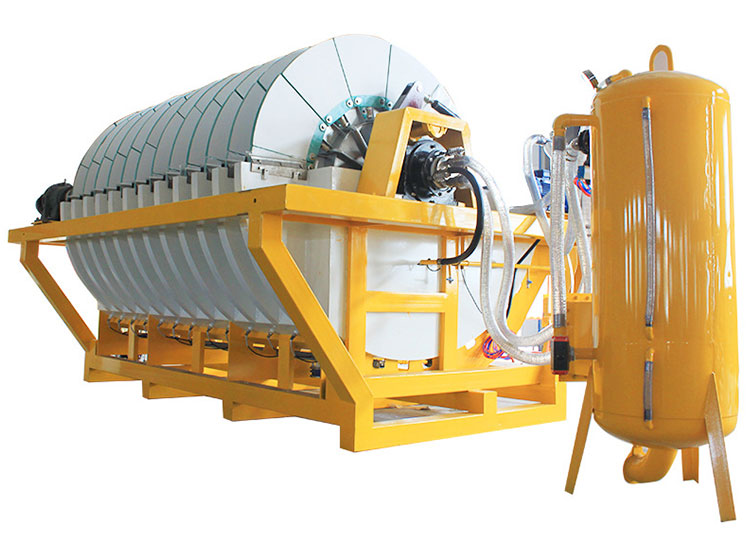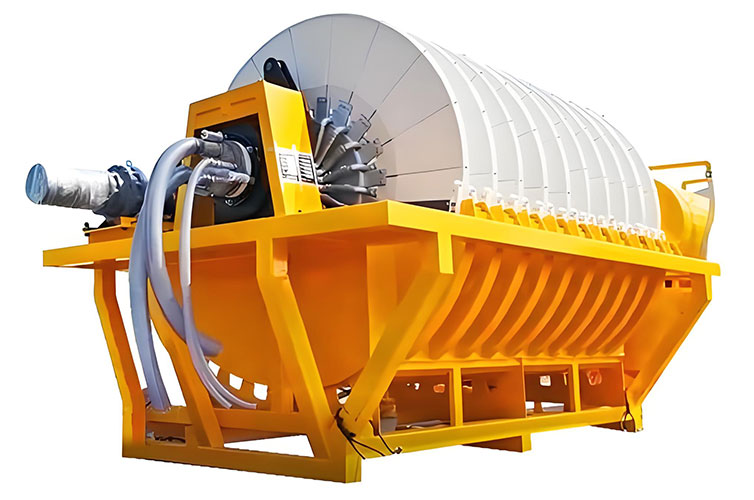In industrial production, vacuum ceramic filters have become a relatively efficient solid-liquid separation device. However, when selecting a vacuum ceramic filter, people consider its service life, safety, and how to clean it. Let's take a look at these factors together.
Service life of vacuum ceramic filter
YiNuo Machinery's vacuum ceramic filter is widely used in the field of industrial solid-liquid separation, and its service life is also a key concern for many customers.

Under normal circumstances, with proper daily maintenance and care, the service life of the entire machine can reach 10 years or even longer. This is mainly because it has been scientifically and reasonably designed, with core components featuring maintenance-free design to effectively reduce failure rates. The interior of the machine is constructed with stainless steel, significantly enhancing corrosion resistance and enabling it to adapt to various complex industrial production environments.
For example, in some metal ore beneficiation plants, Yinuo Machinery's vacuum ceramic filter machines are capable of handling high-concentration, large-particle slurry filtration requirements. Thanks to their robust structure, these machines have been operating continuously and reliably for many years. The filter plates are made of high-strength engineering plastics, with large-sized ribs. The fan-shaped filter plates feature uniformly distributed dewatering holes with reasonable porosity, resulting in a service life 1-1.5 times longer than that of conventional materials and designs. The filter liquid pipes are made of high-strength wear-resistant ceramic composite steel pipes, with a service life over 10 times longer, significantly reducing the frequency of equipment replacement due to damage to critical components.
However, the service life of vacuum ceramic filter machines is not fixed and can be influenced by various factors. If the filter medium is highly corrosive or the operating environment contains excessive dust, abnormal humidity, or other harsh conditions, this can accelerate equipment aging. Additionally, whether daily operations are conducted in a standardized manner and whether maintenance and upkeep are timely and appropriate are also closely related to the equipment's lifespan. For example, if the equipment is not cleaned regularly, leading to severe blockage of the ceramic filter plates, this not only reduces filtration efficiency but may also damage the filter plates over time, thereby affecting the overall lifespan of the machine.
Is it safe to use a vacuum ceramic filter?
When considering both design philosophy and practical application scenarios, vacuum ceramic filters offer a high level of safety. In numerous separation processes involving hazardous chemicals or substances with potential environmental hazards, their excellent sealing performance and reliable stability play a crucial role, ensuring the safety of the entire separation process and effectively eliminating the risk of harmful substance leaks.
Furthermore, the equipment is equipped with a computer monitoring system that enables real-time and precise detection and flexible adjustment of various parameters during the operation process.
Additionally, the structural design of the vacuum ceramic filter is scientifically sound and reasonable, with stable and reliable operational performance. As long as standard operating procedures are strictly followed and routine maintenance is properly conducted during operation, the occurrence of accidents can be minimized.
How to effectively clean vacuum ceramic filters?
When ceramic filtration equipment is shut down for more than 30 minutes due to malfunction or other factors, the equipment needs to be cleaned. This is because prolonged shutdown may cause the filter plates to become clogged, making subsequent cleaning difficult and affecting the normal operation of the equipment.
Under normal circumstances, ceramic filter machines should be shut down for cleaning after 6-7 hours of operation. However, whether cleaning is necessary should be determined based on the actual operating conditions on site. It is important to note that cleaning should not be delayed until the filter plates are severely clogged and unable to function properly, as this will create a vicious cycle and damage the equipment. Each cleaning should ensure that the filter plates are restored to good operating efficiency to ensure stable operation of the equipment.
Each time cleaning is performed, the slurry in the filter machine's mineral tank must be thoroughly cleaned. If there are deposits in the mineral tank, manual cleaning is required. If foreign objects fall to the bottom of the mineral tank, they must be removed immediately. Additionally, the head of the liquid level controller at the bottom of the mineral tank must also be manually cleaned to ensure there are no mineral deposits. Otherwise, the equipment will trigger an alarm mechanism, affecting normal production.

4. During the cleaning process, before opening the filter plate for ultrasonic cleaning, make sure the sensor is completely submerged in the water tank. If the sensor isn't submerged in water, it can easily get damaged during cleaning, which can affect the detection accuracy and normal operation of the device.
5. During normal operation of the ceramic filter machine, the backwash pressure should be controlled within the range of 0.06–0.09 MPa. If the backwash pressure exceeds this range, adjust the pressure promptly to prevent the filter plates from cracking due to excessive pressure. If the backwash pressure is below this range, check whether the filter cartridges are clean, whether the filter cartridge pressure is normal, and whether the pressure relief valve is functioning properly. Low backwash water pressure is generally caused by filter element blockage. Before and after backwashing, carefully check the pressure gauge readings. If the difference between the two readings exceeds 0.1 MPa, the filter element should be replaced promptly.
6. Before cleaning the ceramic filter machine, ensure that the backwash filter cartridge is unobstructed and that the rinse water pressure exceeds 0.3 MPa. Then activate the acid pump to maintain the cleaning agent concentration entering the filter plate at approximately 1%. If the rinse water pressure is below 0.3 MPa, measures must be taken to restore the pressure before injecting the cleaning agent into the filter plate. During the cleaning process, pH test strips should be used regularly to monitor the pH value of the filter plates, maintaining it between 1 and 1.5. If the pH value does not meet requirements, adjust the cleaning agent injection volume from the pump accordingly. Additionally, use a combination of ultrasonic waves and specialized cleaning agents for backwashing, with the backwashing duration not less than 60 minutes.
Summarize
Vacuum ceramic filters play an important role in industrial production. During use, companies should pay attention to cleaning and maintenance to ensure the service life and operational safety of the equipment, thereby better leveraging its advantages in solid-liquid separation and other areas to improve production quality and efficiency.







